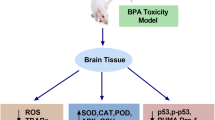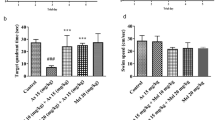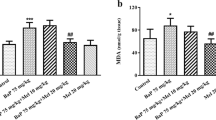Abstract
Benzo(a)pyrene (BaP), a toxic polycyclic aromatic hydrocarbon, is spread in different ways as an environmental pollutant. It has been proposed that BaP can induce toxicity through oxidative stress and apoptosis in vital organs. The present study evaluated the protective effect of melatonin, a circadian hormone of the pineal gland, on BaP-induced neurotoxicity focused on oxidative stress, autophagy, and apoptosis pathways. Thirty male mice in 5 groups were treated daily for 28 consecutive days: (I) control group (BaP and melatonin solvent), (II) BaP (75 mg/kg, orally), (III) and (IV) BaP + melatonin (10 and 20 mg/kg, i.p.), (V) melatonin (20 mg/kg). The oxidative stress markers were determined in the brain. Western blot was conducted for the level of LC3 II/I and Beclin1, as autophagy markers, caspase3 and Bcl2, as apoptosis proteins, and Sirt1 in the brain. The exposure of mice to BaP caused a marked increase in the malondialdehyde (MDA) level and decrease of glutathione (GSH) content in the brain. Furthermore, the Sirt1 level upregulated as well as LC3 II/I, Beclin1, and cleaved caspase3 proteins, while the level of Bcl2 did not change. Melatonin at 20 mg/kg concurrently with BaP restored the BaP alteration in the brain compared with the BaP group. In conclusion, BaP induced brain toxicity via the induction of oxidative stress, apoptosis, and autophagy, whereas melatonin afforded neuroprotection against BaP due to inhibition of these mechanisms.






Similar content being viewed by others
References
Alghamdi BS (2018) The neuroprotective role of melatonin in neurological disorders. J Neurosci Res 96:1136–1149. https://doi.org/10.1002/jnr.24220 PMID: 29498103
Ataizi ZS, Ertilav K, Naziroglu M (2019) Mitochondrial oxidative stress-induced brain and hippocampus apoptosis decrease through modulation of caspase activity, Ca(2+) influx and inflammatory cytokine molecular pathways in the docetaxel-treated mice by melatonin and selenium treatments. Metab Brain Dis 34:1077–1089. https://doi.org/10.1007/s11011-019-00428-x PMID: 31197678
Babaee A, Eftekhar-Vaghefi SH, Asadi-Shekaari M, Shahrokhi N, Soltani SD, Malekpour-Afshar R, Basiri M (2015) Melatonin treatment reduces astrogliosis and apoptosis in rats with traumatic brain injury. Iran J Basic Med Sci 18:867–872 PMID: 26523219
Baird WM, Hooven LA, Mahadevan B (2005) Carcinogenic polycyclic aromatic hydrocarbon-DNA adducts and mechanism of action. Environ Mol Mutagen 45:106–114. https://doi.org/10.1002/em.20095 PMID: 15688365
Bansal V, Kim KH (2015) Review of PAH contamination in food products and their health hazards. Environ Int 84:26–38. https://doi.org/10.1016/j.envint.2015.06.016 PMID: 26203892
Bao Y, Chen Q, Xie Y, Tao Z, Jin K, Chen S, Bai Y, Yang J, Shan S (2019) Ferulic acid attenuates oxidative DNA damage and inflammatory responses in microglia induced by benzo(a)pyrene. Int Immunopharmacol 77:105980. https://doi.org/10.1016/j.intimp.2019.105980 PMID: 31699670
Barangi S, Hayes AW, Reiter R, Karimi G (2019) The therapeutic role of long non-coding RNAs in human diseases: a focus on the recent insights into autophagy. Pharmacol Res 142:22–29. https://doi.org/10.1016/j.phrs.2019.02.010 PMID: 30742900
Barangi S, Mehri S, Moosavi Z, Hayesd AW, Reiter RJ, Cardinali DP, Karimi G (2020) Melatonin inhibits Benzo(a)pyrene-induced apoptosis through activation of the Mir-34a/Sirt1/autophagy pathway in mouse liver. Ecotoxicol Environ Saf 196:110556. https://doi.org/10.1016/j.ecoenv.2020.110556 PMID: 32247962
Boffetta P, Jourenkova N, Gustavsson P (1997) Cancer risk from occupational and environmental exposure to polycyclic aromatic hydrocarbons. Cancer Causes Control 8:444–472. https://doi.org/10.1023/a:1018465507029 PMID: 9498904
Bradford MM (1976) A rapid and sensitive method for the quantitation of microgram quantities of protein utilizing the principle of protein-dye binding. Anal Biochem 72:248–254. https://doi.org/10.1006/abio.1976.9999 PMID: 942051
Carloni S, Favrais G, Saliba E, Albertini MC, Chalon S, Longini M, Gressens P, Buonocore G, Balduini W (2016) Melatonin modulates neonatal brain inflammation through endoplasmic reticulum stress, autophagy, and miR-34a/silent information regulator 1 pathway. J Pineal Res 61:370–380. https://doi.org/10.1111/jpi.12354 PMID: 27441728
Chen Y (2012) Organophosphate-induced brain damage: mechanisms, neuropsychiatric and neurological consequences, and potential therapeutic strategies. Neurotoxicology 33:391–400. https://doi.org/10.1016/j.neuro.2012.03.011 PMID: 22498093
Chepelev NL, Moffat ID, Bowers WJ, Yauk CL (2015) Neurotoxicity may be an overlooked consequence of benzo[a]pyrene exposure that is relevant to human health risk assessment. Mutat Res Rev Mutat Res 764:64–89. https://doi.org/10.1016/j.mrrev.2015.03.001 PMID: 26041267
Cui Y, Zhang Z, Zhang B, Zhao L, Hou C, Zeng Q, Nie J, Yu J, Zhao Y, Gao T, Wang A, Liu H (2018) Excessive apoptosis and disordered autophagy flux contribute to the neurotoxicity induced by high iodine in Sprague-Dawley rat. Toxicol Lett 297:24–33. https://doi.org/10.1016/j.toxlet.2018.08.020 PMID: 30172000
Das DN, Naik PP, Nayak A, Panda PK, Mukhopadhyay S, Sinha N, Bhutia SK (2016) Bacopa monnieri-induced protective autophagy inhibits benzo[a]pyrene-mediated apoptosis. Phytother Res 30:1794–1801. https://doi.org/10.1002/ptr.5682 PMID: 27432245
Das DN, Naik PP, Mukhopadhyay S, Panda PK, Sinha N, Meher BR, Bhutia SK (2017) Elimination of dysfunctional mitochondria through mitophagy suppresses benzo[a]pyrene-induced apoptosis. Free Radic Biol Med 112:452–463. https://doi.org/10.1016/j.freeradbiomed.2017.08.020 PMID: 28843778
Dawson TM, Dawson VL (2003) Molecular pathways of neurodegeneration in Parkinson’s disease. Science 302:819–822. https://doi.org/10.1126/science.1087753 PMID: 14593166
Ding K, Xu J, Wang H, Zhang L, Wu Y, Li T (2015) Melatonin protects the brain from apoptosis by enhancement of autophagy after traumatic brain injury in mice. Neurochem Int 91:46–54. https://doi.org/10.1016/j.neuint.2015.10.008 PMID: 26527380
Edison N, Curtz Y, Paland N, Mamriev D, Chorubczyk N, Haviv-Reingewertz T, Kfir N, Morgenstern D, Kupervaser M, Kagan J, Kim HT, Larisch S (2017) Degradation of Bcl-2 by XIAP and ARTS promotes apoptosis. Cell Rep 21:442–454. https://doi.org/10.1016/j.celrep.2017.09.052 PMID: 29020630
El Asar HM, Mohammed EA, Aboulhoda BE, Emam HY, Imam AA (2019) Selenium protection against mercury neurotoxicity: modulation of apoptosis and autophagy in the anterior pituitary. Life Sci 231:116578. https://doi.org/10.1016/j.lfs.2019.116578 PMID: 31211996
Elmore S (2007) Apoptosis: a review of programmed cell death. Toxicol Pathol 35:495–516. https://doi.org/10.1080/01926230701320337 PMID: 17562483
Emre MH, Aktay G, Polat A, Vardt N (2007) Effects of benzo(a)pyrene and ethanol on oxidative stress of brain, lung tissues and lung morphology in rats. Chin J Physiol 50:143–148 PMID: 17867435
Galano A, Tan DX, Reiter RJ (2011) Melatonin as a natural ally against oxidative stress: a physicochemical examination. J Pineal Res 51:1–16. https://doi.org/10.1111/j.1600-079X.2011.00916.x PMID: 21752095
Galano A, Tan DX, Reiter RJ (2013) On the free radical scavenging activities of melatonin’s metabolites, AFMK and AMK. J Pineal Res 54:245–257. https://doi.org/10.1111/jpi.12010 PMID: 22998574
Ghavami S, Shojaei S, Yeganeh B, Ande SR, Jangamreddy JR, Mehrpour M, Christoffersson J, Chaabane W, Moghadam AR, Kashani HH, Hashemi M, Owji AA, Los MJ (2014) Autophagy and apoptosis dysfunction in neurodegenerative disorders. Prog Neurobiol 112:24–49. https://doi.org/10.1016/j.pneurobio.2013.10.004 PMID: 24211851
Guo JY, Li F, Wen YB, Cui HX, Guo ML, Zhang L, Zhang YF, Guo YJ, Guo YX (2017) Melatonin inhibits Sirt1-dependent NAMPT and NFAT5 signaling in chondrocytes to attenuate osteoarthritis. Oncotarget 8:55967–55983. https://doi.org/10.18632/oncotarget.18356 PMID: 28915567
He J, Ji X, Li Y, Xue X, Feng G, Zhang H, Wang H, Gao M (2016) Subchronic exposure of benzo(a)pyrene interferes with the expression of Bcl-2, Ki-67, C-myc and p53, Bax, caspase-3 in sub-regions of cerebral cortex and hippocampus. Exp Toxicol Pathol 68:149–156. https://doi.org/10.1016/j.etp.2015.11.007 PMID: 26679980
Hu Y, Wang Z, Liu Y, Pan S, Zhang H, Fang M, Jiang H, Yin J, Zou S, Li Z, Zhang H, Lin Z, Xiao J (2017) Melatonin reduces hypoxic-ischaemic (HI) induced autophagy and apoptosis: an in vivo and in vitro investigation in experimental models of neonatal HI brain injury. Neurosci Lett 653:105–112. https://doi.org/10.1016/j.neulet.2016.11.050 PMID: 28341477
Huang YN, Yang LY, Wang JY, Lai CC, Chiu CT, Wang JY (2017) L-Ascorbate protects against methamphetamine-induced neurotoxicity of cortical cells via inhibiting oxidative stress, autophagy, and apoptosis. Mol Neurobiol 54:125–136. https://doi.org/10.1007/s12035-015-9561-z PMID: 26732595
Karbasforooshan H, Karimi G (2018) The role of SIRT1 in diabetic retinopathy. Biomed Pharmacother 97:190–194. https://doi.org/10.1016/j.biopha.2017.10.075 PMID: 29091865
Kroemer G, Levine B (2008) Autophagic cell death: the story of a misnomer. Nat Rev Mol Cell Biol 9:1004–1010. https://doi.org/10.1038/nrm2529 PMID: 18971948
Kundurovic Z, Sofic E (2006) The effects of exogenous melatonin on the morphology of thyrocytes in pinealectomized and irradiated rats. J Neural Transm (Vienna) 113:49–58. https://doi.org/10.1007/s00702-005-0396-z PMID: 16372145
Li H, Wang Y, Feng D, Liu Y, Xu M, Gao A, Tian F, Zhang L, Cui Y, Wang Z, Chen G (2014) Alterations in the time course of expression of the Nox family in the brain in a rat experimental cerebral ischemia and reperfusion model: effects of melatonin. J Pineal Res 57:110–119. https://doi.org/10.1111/jpi.12148 PMID: 24867613
Li M, Tan J, Miao Y, Lei P, Zhang Q (2015) The dual role of autophagy under hypoxia-involvement of interaction between autophagy and apoptosis. Apoptosis 20:769–777. https://doi.org/10.1007/s10495-015-1110-8 PMID: 25721361
Li Q, Gao C, Deng H, Song Q, Yuan L (2019) Benzo[a]pyrene induces pyroptotic and autophagic death through inhibiting PI3K/Akt signaling pathway in HL-7702 human normal liver cells. J Toxicol Sci 44:121–131. https://doi.org/10.2131/jts.44.121 PMID: 30726812
Liang X, Tang Y, Duan L, Cheng S, Luo L, Cao X, Tu B (2014) Adverse effect of sub-chronic exposure to benzo(a)pyrene and protective effect of butylated hydroxyanisole on learning and memory ability in male Sprague-Dawley rat. J Toxicol Sci 39:739–748. https://doi.org/10.2131/jts.39.739 PMID: 25242404
Lim HD, Kim YS, Ko SH, Yoon IJ, Cho SG, Chun YH, Choi BJ, Kim EC (2012) Cytoprotective and anti-inflammatory effects of melatonin in hydrogen peroxide-stimulated CHON-001 human chondrocyte cell line and rabbit model of osteoarthritis via the SIRT1 pathway. J Pineal Res 53:225–237. https://doi.org/10.1111/j.1600-079X.2012.00991.x PMID: 22507555
Lu J, Zhang M, Huang Z, Sun S, Zhang Y, Zhang L, Peng L, Ma A, Ji P, Dai J, Cui T, Liu H, Gao J (2015) SIRT1 in B[a]P-induced lung tumorigenesis. Oncotarget 6:27113–27129. https://doi.org/10.18632/oncotarget.4729 PMID: 26318035
Lustbader JW, Cirilli M, Lin C, Xu HW, Takuma K, Wang N, Caspersen C, Chen X, Pollak S, Chaney M, Trinchese F, Liu S, Gunn-Moore F, Lue LF, Walker DG, Kuppusamy P, Zewier ZL, Arancio O, Stern D, Yan SS, Wu H (2004) ABAD directly links Abeta to mitochondrial toxicity in Alzheimer’s disease. Science 304:448–452. https://doi.org/10.1126/science.1091230 PMID: 15087549
Madrigal JL, Moro MA, Lizasoain I, Lorenzo P, Fernandez AP, Rodrigo J, Bosca L, Leza JC (2003) Induction of cyclooxygenase-2 accounts for restraint stress-induced oxidative status in rat brain. Neuropsychopharmacology 28:1579–1588. https://doi.org/10.1038/sj.npp.1300187 PMID: 12784118
Malik AI, Williams A, Lemieux CL, White PA, Yauk CL (2012) Hepatic mRNA, microRNA, and miR-34a-target responses in mice after 28 days exposure to doses of benzo(a)pyrene that elicit DNA damage and mutation. Environ Mol Mutagen 53:10–21. https://doi.org/10.1002/em.20668 PMID: 21964900
Mao J, Yang J, Zhang Y, Li T, Wang C, Xu L, Hu Q, Wang X, Jiang S, Nie X, Chen G (2016) Arsenic trioxide mediates HAPI microglia inflammatory response and subsequent neuron apoptosis through p38/JNK MAPK/STAT3 pathway. Toxicol Appl Pharmacol 303:79–89. https://doi.org/10.1016/j.taap.2016.05.003 PMID: 27174766
Mihara M, Uchiyama M (1978) Determination of malondialdehyde precursor in tissues by thiobarbituric acid test. Anal Biochem 86:271–278. https://doi.org/10.1016/0003-2697(78)90342-1 PMID: 655387
Moron MS, Depierre JW, Mannervik B (1979) Levels of glutathione, glutathione reductase and glutathione S-transferase activities in rat lung and liver. Biochim Biophys Acta 582:67–78. https://doi.org/10.1016/0304-4165(79)90289-7 PMID: 760819
Murawska-Cialowicz E, Jethon Z, Magdalan J, Januszewska L, Podhorska-Okolow M, Zawadzki M, Sozanski T, Dziegiel P (2011) Effects of melatonin on lipid peroxidation and antioxidative enzyme activities in the liver, kidneys and brain of rats administered with benzo(a)pyrene. Exp Toxicol Pathol 63:97–103. https://doi.org/10.1016/j.etp.2009.10.002 PMID: 19944579
Nie JS, Zhao J, Wang J (2009) Pathological changes and cell apoptosis of hippocampus in rats induced by repeated injection of benzopyrene in lateral ventricle. Zhonghua Lao Dong Wei Sheng Zhi Ye Bing Za Zhi 27:40–43 PMID: 19224694
Nie JS, Zhang HM, Zhao J, Liu HJ, Niu Q (2014) Involvement of mitochondrial pathway in benzo[a]pyrene-induced neuron apoptosis. Hum Exp Toxicol 33:240–250. https://doi.org/10.1177/0960327113493301 PMID: 23839155
Ohkawa H, Ohishi N, Yagi K (1979) Assay for lipid peroxides in animal tissues by thiobarbituric acid reaction. Anal Biochem 95:351–358. https://doi.org/10.1016/0003-2697(79)90738-3 PMID: 36810
Pan X, Zhu L, Lu H, Wang D, Lu Q, Yan H (2015) Melatonin attenuates oxidative damage induced by acrylamide in vitro and in vivo. Oxidative Med Cell Longev 2015:703709–703712. https://doi.org/10.1155/2015/703709. PMID: 26185593
Pazar A, Kolgazi M, Memisoglu A, Bahadir E, Sirvanci S, Yaman A, Yegen BC, Ozek E (2016) The neuroprotective and anti-apoptotic effects of melatonin on hemolytic hyperbilirubinemia-induced oxidative brain damage. J Pineal Res 60:74–83. https://doi.org/10.1111/jpi.12292 PMID: 26511903
Perier C, Bove J, Vila M (2012) Mitochondria and programmed cell death in Parkinson’s disease: apoptosis and beyond. Antioxid Redox Signal 16:883–895. https://doi.org/10.1089/ars.2011.4074 PMID: 21619488
Phillips DH, Venitt S (2012) DNA and protein adducts in human tissues resulting from exposure to tobacco smoke. Int J Cancer 131:2733–2753. https://doi.org/10.1002/ijc.27827 PMID: 22961407
Roohbakhsh A, Shamsizadeh A, Hayes AW, Reiter RJ, Karimi G (2018) Melatonin as an endogenous regulator of diseases: the role of autophagy. Pharmacol Res 133:265–276. https://doi.org/10.1016/j.phrs.2018.01.022 PMID: 29408249
Saunders CR, Das SK, Ramesh A, Shockley DC, Mukherjee S (2006) Benzo(a)pyrene-induced acute neurotoxicity in the F-344 rat: role of oxidative stress. J Appl Toxicol 26:427–438. https://doi.org/10.1002/jat.1157 PMID: 16858674
Schellenberger MT, Grova N, Farinelle S, Willieme S, Schroeder H, Muller CP (2013) Modulation of benzo[a]pyrene induced neurotoxicity in female mice actively immunized with a B[a]P-diphtheria toxoid conjugate. Toxicol Appl Pharmacol 271:175–183. https://doi.org/10.1016/j.taap.2013.05.007 PMID: 23684556
Shah SA, Khan M, Jo MH, Jo MG, Amin FU, Kim MO (2017) Melatonin stimulates the SIRT1/Nrf2 signaling pathway counteracting lipopolysaccharide (LPS)-induced oxidative stress to rescue postnatal rat brain. CNS Neurosci Ther 23:33–44. https://doi.org/10.1111/cns.12588 PMID: 27421686
Shi L, Liang F, Zheng J, Zhou K, Chen S, Yu J, Zhang J (2018) Melatonin regulates apoptosis and autophagy via ROS-MST1 pathway in subarachnoid hemorrhage. Front Mol Neurosci 11:93. https://doi.org/10.3389/fnmol.2018.00093 PMID: 29632474
Solmaz I, Gurkanlar D, Gokcil Z, Goksoy C, Ozkan M, Erdogan E (2009) Antiepileptic activity of melatonin in guinea pigs with pentylenetetrazol-induced seizures. Neurol Res 31:989–995. https://doi.org/10.1179/174313209x385545 PMID: 19138464
Tabeshpour J, Mehri S, Abnous K, Hosseinzadeh H (2019) Neuroprotective effects of thymoquinone in acrylamide-induced peripheral nervous system toxicity through MAPKinase and apoptosis pathways in rat. Neurochem Res 44:1101–1112. https://doi.org/10.1007/s11064-019-02741-4 PMID: 30725239
Tordjman S, Chokron S, Delorme R, Charrier A, Bellissant E, Jaafari N, Fougerou C (2017) Melatonin: pharmacology, functions and therapeutic benefits. Curr Neuropharmacol 15:434–443. https://doi.org/10.2174/1570159x14666161228122115 PMID: 28503116
Tu B, Cheng S, Hu X (2004) Effects on the survival rates and damage on DNA of benzo[a]pyrene or lead alone or in combination in rat neurons in vivo. Wei Sheng Yan Jiu 33:660–662 PMID: 15727170
Wang Z, Zhou F, Dou Y, Tian X, Liu C, Li H, Shen H, Chen G (2018) Melatonin alleviates intracerebral hemorrhage-induced secondary brain injury in rats via suppressing apoptosis, inflammation, oxidative stress, DNA damage, and mitochondria injury. Transl Stroke Res 9:74–91. https://doi.org/10.1007/s12975-017-0559-x PMID: 28766251
Watson N, Diamandis T, Gonzales-Portillo C, Reyes S, Borlongan CV (2016) Melatonin as an antioxidant for stroke neuroprotection. Cell Transplant 25:883–891. https://doi.org/10.3727/096368915x689749 PMID: 26497887
Wu HJ, Pu JL, Krafft PR, Zhang JM, Chen S (2015) The molecular mechanisms between autophagy and apoptosis: potential role in central nervous system disorders. Cell Mol Neurobiol 35:85–99. https://doi.org/10.1007/s10571-014-0116-z PMID: 25257832
Xia Y, Cheng S, He J, Liu X, Tang Y, Yuan H, He L, Lu T, Tu B, Wang Y (2011) Effects of subchronic exposure to benzo[a]pyrene (B[a]P) on learning and memory, and neurotransmitters in male Sprague-Dawley rat. Neurotoxicology 32:188–198. https://doi.org/10.1016/j.neuro.2010.12.015 PMID: 21216261
Yang Y, Jiang S, Dong Y, Fan C, Zhao L, Yang X, Li J, Di S, Yue L, Liang G, Reiter RJ, Qu Y (2015) Melatonin prevents cell death and mitochondrial dysfunction via a SIRT1-dependent mechanism during ischemic-stroke in mice. J Pineal Res 58:61–70. https://doi.org/10.1111/jpi.12193 PMID: 25401748
Yang W, Zhang G, Jiang F, Zeng Y, Zou P, An H, Chen Q, Ling X, Han F, Liu W, Yang H, Liu J, Cao J, Ao L (2019) BPDE and B[a]P induce mitochondrial compromise by ROS-mediated suppression of the SIRT1/TERT/PGC-1alpha pathway in spermatogenic cells both in vitro and in vivo. Toxicol Appl Pharmacol 376:17–37. https://doi.org/10.1016/j.taap.2019.05.004 PMID: 31085209
Yuan L, Liu J, Deng H, Gao C (2017) Benzo[a]pyrene induces autophagic and pyroptotic death simultaneously in HL-7702 human normal liver cells. J Agric Food Chem 65:9763–9773. https://doi.org/10.1021/acs.jafc.7b03248 PMID: 28990778
Zhang HM, Nie JS, Wang F, Shi YT, Zhang L, Antonucci A, Liu HJ, Wang J, Zhao J, Zhang QL, Wang LP, Song J, Xue CE, Di Gioacchino M, Niu Q (2008) Effects of benzo[a]pyrene on autonomic nervous system of coke oven workers. J Occup Health 50:308–316. https://doi.org/10.1539/joh.l7155 PMID: 18490851
Zhang P, Ye Y, Qian Y, Yin B, Zhao J, Zhu S, Zhang L, Yan M (2017) The effect of pyrroloquinoline quinone on apoptosis and autophagy in traumatic brain injury. CNS Neurol Disord Drug Targets 16:724–736. https://doi.org/10.2174/1871527316666170124164306 PMID: 28124619
Zhao L, An R, Yang Y, Yang X, Liu H, Yue L, Li X, Lin Y, Reiter RJ, Qu Y (2015) Melatonin alleviates brain injury in mice subjected to cecal ligation and puncture via attenuating inflammation, apoptosis, and oxidative stress: the role of SIRT1 signaling. J Pineal Res 59:230–239. https://doi.org/10.1111/jpi.12254 PMID: 26094939
Funding
This paper was financially supported by the Vice Chancellor of Research, Mashhad University of Medical Sciences, Mashhad, Iran (Grant No. 97181).
Author information
Authors and Affiliations
Contributions
SM and SB wrote the paper and analyzed the data. SB and EZ performed the experiments. GK conceived and designed the experiments. All authors read and approved the manuscript and all data were generated in-house and that no paper mill was used.
Corresponding author
Ethics declarations
Conflict of interest
The authors declare that they have no conflict of interest.
Ethics approval
All experiments were performed according to the ethical committee guidelines of Mashhad University of Medical Sciences (ethical number: 971781).
Additional information
Publisher’s note
Springer Nature remains neutral with regard to jurisdictional claims in published maps and institutional affiliations.
Rights and permissions
About this article
Cite this article
Mehri, S., Barangi, S., Zamiri, E. et al. The protective effect of melatonin on benzo(a)pyrene-induced brain injury: role of apoptosis and autophagy pathways. Naunyn-Schmiedeberg's Arch Pharmacol 393, 2241–2251 (2020). https://doi.org/10.1007/s00210-020-01936-9
Received:
Accepted:
Published:
Issue Date:
DOI: https://doi.org/10.1007/s00210-020-01936-9




